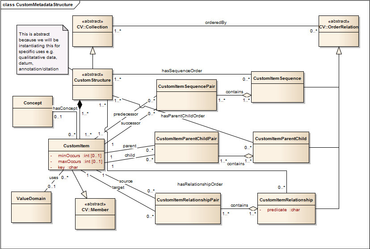- Created by Wendy Thomas, last modified by Larry Hoyle on May 29, 2015
You are viewing an old version of this page. View the current version.
Compare with Current View Page History
« Previous Version 8 Next »
The Enhanced Citation model was presented in several venues and comments were consideredin revising the model. This included:
- renaming a number of objects
- using the revised model for OrderRelations
- adding a hasConcept relationship to CustomItem
- adding a key property to CustomItem
- adding a key and a value property to CustomValue
- setting CustomInstance and CustomValue to inherit from Identifiable
The models for custom metadata and controlled vocabularies have been entered into the Drupal siite (lion) as the CustomMetadata package. We discussed adding CustomInstance to Annotation but that has not yet been done.
We also discussed which parts of the openEHR blood pressure model ( https://omowizard.files.wordpress.com/2010/01/bp-mindmap.jpg ) might be described as custom metadata and which parts might be collected as data. An intended protocol description might be made using custom metadata with keys of CuffSize, Location, Method, MeanArterialPressureFormula etc. ass keys in an openEHR related CustomStructure. At the same time the data description group discussed how some of these same elements in other situations (e.g. where the protocol might vary for each patient) might be collected in event tagged DatumStructures.
As of 2015-05-29 that package includes the following classes
CustomMetadata
- CustomItem
- CustomStructure
- CustomValue
- CustomInstance
- CustomItemParentChildPair
- CustomItemSequencePair
- CustomItemRelationshipPair
- CustomItemParentChild
- CustomItemRelationship
- CustomItemSequence
- CustomValueSequencePair
- CustomValueParentChildPair
- CustomValueRelationshipPair
- CustomValueRelationship
- CustomValueParentChild
- CustomValueSequence
- VocabularyEntry
- ControlledVocabulary
- VocabularyParentChildPair
- VocabularySequencePair
- VocabularySequence
- VocabularyParentChild
Work on representing these classes in Enterprise Architect is ongoing. The following diagrams do not yet show cardinalities.
The Controlled Vocabulary Model

Defining a custom metadata model

Using a custom metadata model ( populating an instance)

Attendees: Anders Swensrud, Anita Rocha, Arofan Gregory, Daniel Gillman, Flavio Rizzolo, Jay Greenfield, Joachim Wackerow, Larry Hoyle, Michelle Edwards, Simon Lloyd, Steve McEachern, Wendy Thomas
Metamodel discussion 2015-05-25
Arofan gave a brief review of his paper: “Structured Custom Metadata: How Do We Include External Metadata in the DDI?”
This included a review of existing methods of extending DDI with external information. Name value pairs, and XML schema extensions
The pre-NADDI2015 work created a model for representing Controlled vocabularies in DDI. It also created a model for describing a model (a metamodel) along with a model for representing instances from the new model. This should allow users to create a new structure on the fly, but one that can be validated and shared. Beyond key value pairs it would allow the specification of cardinalities and order relations. This new model fulfills the role of UserAttributePairs in 3.x.
This model recognizes that other classes of objects can be organized similarly to the way variables can be organized. Similar to how data can be organized but we have DDI legacy issues, and known data structures (e.g. CSV file).
Dan suggested looking at 11404 “type generator” as a model for defining structure.
He also noted that the distinction between a measure and an attribute is dependent on their use.
Arofan and Larry (and others?) will meet to refine the models and enter them into Drupal. Some of the issues to be addressed include:
Where should Concepts be applied? Is a notion of Universe of Population needed or will it be implicit in the relationhips of the metamodel to the rest of the DDI objects?
From what do CM:Value and CM:Report inherit?
The conversation moved on to Data Description.
Beyond recognizing the need to handle the structures that DDI3.x can, we noted several data structures which are currently not handled in DDI4
Event history data?
Qualitative data,
Relational structures (including explicit modeling of primary and foreign keys
aggregate data (the connection of microdata to aggregate data back and forth). Is this really a different structure than microdata
the provenance of data - transformations
Network data (graphs/RDF)
We agreed for this sprint to list (park) new data types
Can Datum be used on Qualitative? Achim noted that a (quantitive) Datum describes an observation. A qualitative object does the same thing. There is overlap here. Others noted that segmentation of a qualitative object complicates that picture.
We discussed the need to tie Unit and UnitType to a lower level than logical record (to Datum?).
We agreed to work next on data structure at the logical level first and then at the physical level.
ATTENDEES: Larry, Arofan, Wendy, Sanda
Discussed and revised paper on Structured Custom Metadata
Proposed a joint meeting between the Modelers and the Data Description Team to discuss paper and its relevance to the work of the Data Description Group
- No labels